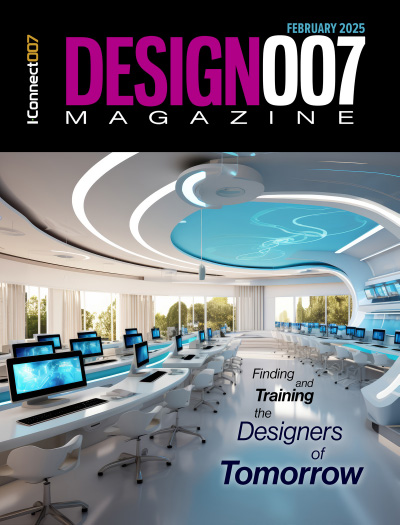-

- News
- Books
Featured Books
- design007 Magazine
Latest Issues
Current Issue
Designing Through the Noise
Our experts discuss the constantly evolving world of RF design, including the many tradeoffs, material considerations, and design tips and techniques that designers and design engineers need to know to succeed in this high-frequency realm.

Learning to Speak ‘Fab’
Our expert contributors clear up many of the miscommunication problems between PCB designers and their fab and assembly stakeholders. As you will see, a little extra planning early in the design cycle can go a long way toward maintaining open lines of communication with the fab and assembly folks.

Training New Designers
Where will we find the next generation of PCB designers and design engineers? Once we locate them, how will we train and educate them? What will PCB designers of the future need to master to deal with tomorrow’s technology?
- Articles
- Columns
Search Console
- Links
- Media kit
||| MENU - design007 Magazine
XNC Format: Gerber Takes Data Into the Future
May 20, 2019 | Denis Morin, Karel Tavernier, Jean-Pierre Charras, and Marius MatiocEstimated reading time: 2 minutes
Gerber is the world’s favourite data exchange format for PCB image data: it’s easy to use, crystal clear, and gives designers and engineers an unequivocal language with which to communicate with each other. And this grand old man of the PCB industry has remained at the forefront, powered by ongoing developments that add capability and functionality without ever compromising its characteristic simplicity and ease of use.
It’s the ideal solution for transferring drill data too, as can be seen from scanning the specification. And many in the PCB industry use it for just this, but the majority are still transferring their routing and drilling coordinates using NC formats. These were never designed for data transfer, and more often than not create confusion and waste time.
Some argue that Gerber files, unlike NC files, can’t be sent to a drilling machine. True enough, but PCB manufacturers never send their clients’ incoming files to their machines anyway. Instead, the data goes through the CAM process and is then altered and output as is appropriate to the manufacturer’s specific production line. For CAD, the question should not be which format is best for the machines, but rather which format is best for input into CAM. As we’ve said, this is undoubtedly Gerber.
So, why are CAD developers and their users still stuck on NC formats? It’s most likely a question of inertia or tradition. Drill information has been transferred for decades using NC formats, principally Excellon (hence the generic use of the name “Excellon” for “NC files”), that are similar to the 1985 IPC-NC349 specification. Also, there’s still a lot of legacy software out there, so NC files will likely be with us for a while.
The Problem With Existing NC Specifications
The problem is that so many NC files are of deplorable quality because the NC format was never designed as a data transfer format. It has always been a machine driver and contains all sorts of information that a drilling machine needs, but that is irrelevant and confusing for data exchange. For example, CAD software will typically ask users to specify whether routing should be achieved using nibbling or slot creation and which drill feeds and speeds are to be used. These are decisions that only the fabricator can make, and yet many CAD professionals will feel duty bound to give some sort of answer, which will inevitably be wrong.
To read this entire article, which appeared in the April 2019 issue of Design007 Magazine, click here.
Suggested Items
Nick Koop Launches IPC Flex Design Class
05/06/2025 | Andy Shaughnessy, Design007 MagazineNick Koop is director of flex technology for TTM Technologies, and he’s been a staple of IPC’s flex committees for decades. He’s also a longtime flex design instructor, and he’s about to debut a new IPC class, Flex and Rigid-Flex Design for Manufacturability, which will run May 12–21. In this interview, Nick tells us about this new class and what attendees can expect to learn.
The Government Circuit: Trump’s Trade War Disrupts the Electronics Ecosystem
05/06/2025 | Chris Mitchell -- Column: The Government CircuitThere is certainly no shortage of work to be done in the IPC Government Relations department, as the U.S. waged a tariff campaign on practically every industrial country in the world and several countries embarked on high-tech initiatives with a mix of approaches to the crucial foundations of electronics manufacturing. Indeed, the breadth and speed of U.S. President Donald Trump’s tariff campaign continues to be a serious challenge for our industry.
Meet Thiago Guimaraes, IPC's New Director of Industry Intelligence
05/05/2025 | Chris Mitchell, IPC VP, Global Government RelationsThe fast pace of innovation in the electronics manufacturing industry means business owners must continuously adapt their processes and capabilities to meet changing customer demands and market trends. To that end, IPC has hired Thiago Guimaraes as the new director of Industry Intelligence. In this interview, Thiago shares key goals and objectives that could revolutionize the industry as he helps stakeholders navigate industry trends and challenges.
Nolan's Notes: The Next Killer App in Component Manufacturing
05/02/2025 | Nolan Johnson -- Column: Nolan's NotesFor quite a while, I’ve been wondering what the next “killer app” will be in electronics manufacturing and why it has been so long since the last disruptive change in EMS. I believe the answer lies in artificial intelligence, which has exploded as the next disruptor.
IPC Excellence in Education Award: Zenaida Valianu
05/01/2025 | Nolan Johnson, I-Connect007Zenaida Valianu is the training manager at IPC who brings more than 25 years of expertise in standards and training development to her role. She has revolutionized IPC certification training programs by significantly enhancing their content with comprehensive curricula and engaging materials. She has also been instrumental in developing essential workforce training courses and contributing to various other initiatives.


